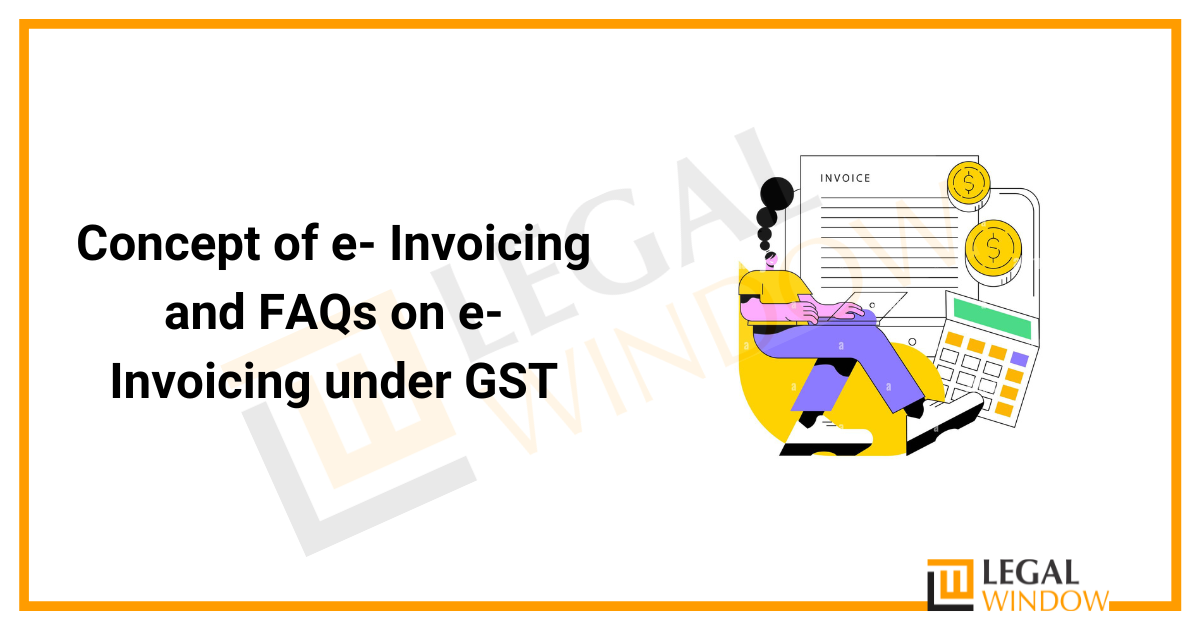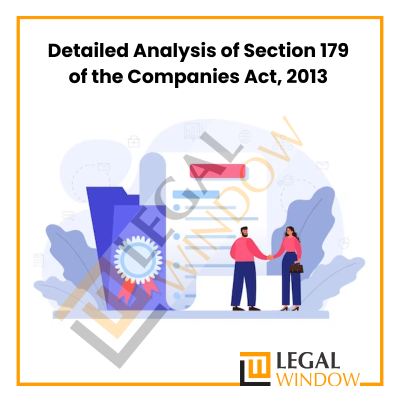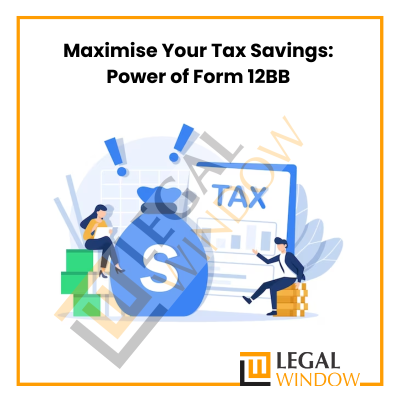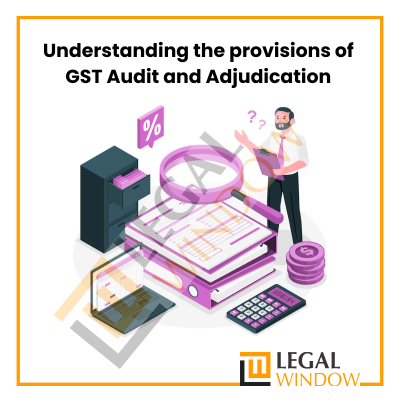
Are you also, looking for filing up of invoice of business? In that case you have landed up on the right place. The submission of ‘e-Way Bills’ on the unified GST platform facilitates the delivery of products from one location to another. Similarly, in its 35th meeting, the GST Council resolved to develop an e-Invoicing system that will apply to specified groups of people. The production of invoices on the GST site does not constitute e-invoicing. That would be a legend. Instead, e-invoicing entails submitting a pre-generated standard invoice to a common e-invoice gateway. As a result, it automates multi-purpose reporting with a single entry of invoice facts. Through Notification No.69/2019 – Central Tax, the CBIC issued a set of common gateways to produce e-invoices. In this article we’ll discuss about concept of e- Invoicing and FAQs on e-Invoicing under GST.
| Table of Content |
Key Abstract
‘e-Invoicing’ or ‘electronic invoicing’ refers to a system in which B2B invoices are electronically verified by GSTN for use on the shared GST site. The Invoice Registration Portal (IRP), maintained by the GST Network, will assign an identifying number to each invoice under the electronic invoicing system (GSTN). Einvoice1.gst.gov.in was the first IRP launched by the National Informatics Centre.
All invoice information will be sent in real time from this site to the GST portal and the e-way bill portal. As a result, because the information is transferred directly from the IRP to the GST site, there would be no need for manual data entry for filing GSTR-1 returns or generating part-A of e-way bills.
The present GST Invoicing System
Today, a seller’s invoice must be written and transmitted to two distinct systems: GST Portal and e-Way Bill.
Businesses create invoices using various software, and the taxpayer enters the invoice information into a GSTR-1 return using a relevant API. The identical information appears on a GSTR-2A and is made available to recipients with ‘see only’ access. Simultaneously, carriers must create the e-Way Bill, either immediately or by manually inputting the invoices into an excel sheet or JSON.
The GST Council created the new return method to put a stop to this never-ending trail of paperwork.
File your GST Returns through Legal Window, our team of professionals handles the Taxation with ease.
The Advantages of Using an E-Invoicing System
A taxpayer who reports to the IRP in GST is normally responsible for creating a GST e-invoice. The IRP will then create a unique IRN as well as a QR code. The taxpayer will be able to scan this QR code in order to obtain the IRN and invoice data.
Here are some of the advantages of e-invoicing for businesses:
- E-invoicing aids in data reconciliation and accuracy when manual data entry is used.
- It enables cross-business interoperability.
- The e-invoices may be tracked in real time.
- The information of the e-invoice will be auto-populated on tax return forms and e-way bills, simplifying the tax return procedure.
- At all times, all transaction details will be available online. This eliminates the need for regular audits and surveys. Data differences can be identified by comparing input credit and output tax.
- This program will also improve tax administration efficiency by assisting in the detection of fraudulent invoices.
E-Invoicing FAQs under GST– Frequently Asked Questions
The GST e-Invoicing system became live on October 1, 2020, for taxpayers with an aggregate revenue of more than Rs.500 crore. E-invoicing was expanded to enterprises with a combined annual revenue of more than Rs.100 crore on January 1, 2021.
The CBIC has notified the implementation of the e-invoicing system from 1st April 2021 for enterprises with total sales ranging between Rs.50 crore and Rs.100 crore on March 8, 2021. The government recently expanded the use of e-invoicing to firms with a turnover of more than Rs 20 crore from April 1, 2022.
The aggregate turnover for e-invoicing shall include the turnover of all GSTINs in India under a single PAN. This page answers frequently asked questions about the GST e-invoicing system.
Who will be affected by e-invoicing?
The GST registered persons whose aggregate turnover in the fiscal year exceeds Rs.50 crore are subject to the e-invoicing system. It will apply to those with a turnover of greater than Rs.20 crore as of April 1, 2022.
Also, if your revenue exceeds Rs 20 crore in any fiscal year beginning in 2017-18, you must implement e-invoicing. So, if your revenue was less than Rs 20 crore last year and exceeded Rs 20 crore this year, you must begin issuing e-invoices.
Special Economic Zones (SEZ) units, insurance, banking, financial institutions, NBFCs, GTA, passenger transportation service, and the sale of cinema tickets are exceptions. Special Economic Zones (SEZ) units, insurance, banking, financial institutions, NBFCs, GTA, passenger transportation service, and the sale of cinema tickets are exceptions.
Can an e-invoice be partially or completely cancelled?
An e-invoice cannot be cancelled in part, but it can be cancelled entirely. When a reservation is cancelled, it must be notified to the IRN within 24 hours. Any subsequent cancellation attempts cannot be made on the IRN and must be done manually on the GST site before the returns are filed.
Will it be feasible to bulk submit invoices for IRN generation?
No, invoices must be entered into the IRP one at a time. A company’s ERP system must be configured to accept requests for individual invoice uploads.
Will the unified GST portal support the creation of e-invoices?
No, invoices will continue to be created on the particular ERP software that firms now use. The invoice must follow the e-invoicing standard format and include all required characteristics. Direct invoice creation through a shared interface is not yet envisaged.
What are the different sorts of documents that must be disclosed to the IRP?
The following documents will be covered by the e-invoicing system:
- Invoices issued by the supplier
- Supplier’s credit notes
- The recipient’s debit notes
- Any other document required by GST legislation to be submitted as an e-invoice by the document’s originator
How do I know if I need to register invoices?
You can check the e-Invoice site to see if you have been granted permission to register invoices based on past year filings.
Go to https://einvoice1.gst.gov.in and search for “e-Invoice Status of taxpayer.”
Can I link my system with the e-Invoice system through API?
If your revenue exceeds Rs.500 crores, you can interface directly with IRP through API. If the turnover is less than Rs.500 crores, the supplier or receiver must be connected through GSP/ERP. If the turnover is greater than Rs.500 crores, the supplier or recipient must be integrated directly with IRP.
What are the invoice registration options for taxpayers having a turnover of less than Rs.500 crores?
You can integrate utilizing API through GSP/ERP or taxpayers with a turnover of more than Rs. 500 crores who have direct API access. Make use of offline tools like bulk generation or GePP-Off. GePP-On may be used to register invoices online or offline. Install and utilize the mobile application.
Can I link my system with the e-Invoice system through API?
If your revenue exceeds Rs.500 crores, you can interface directly with IRP through API. If the turnover is less than Rs.500 crores, the supplier or receiver must be connected through GSP/ERP. If the turnover is greater than Rs.500 crores, the supplier or recipient must be integrated directly with IRP.
What are the invoice registration options for taxpayers having a turnover of less than Rs.500 crores?
You can integrate utilizing API through GSP/ERP or taxpayers with a turnover of more than Rs. 500 crores who have direct API access. Make use of offline tools like bulk generation or GePP-Off. GePP-On may be used to register invoices online or offline. Install and utilize the mobile application.
Endnote
With the implementation of e-invoicing, tax authorities will now have a complete trail of B2B invoices from taxpayers, since they will be submitted to the GST system. Because invoices are generated prior to any real transaction, possibilities to falsify them are reduced. The technology may detect fraudulent invoices by comparing the input tax credit to the output tax on the GSTN site, so eliminating tax evasion. Further, it proves to be a suitable asset for the government.
CA Pulkit Goyal, is a fellow member of the Institute of Chartered Accountants of India (ICAI) having 10 years of experience in the profession of Chartered Accountancy and thorough understanding of the corporate as well as non-corporate entities taxation system. His core area of practice is foreign company taxation which has given him an edge in analytical thinking & executing assignments with a unique perspective. He has worked as a consultant with professionally managed corporates. He has experience of writing in different areas and keep at pace with the latest changes and analyze the different implications of various provisions of the act.
Categories
- Agreement Drafting (23)
- Annual Compliance (11)
- Change in Business (36)
- Company Law (148)
- Compliance (89)
- Digital Banking (3)
- Drug License (3)
- FEMA (17)
- Finance Company (42)
- Foreign Taxation (6)
- FSSAI License/Registration (14)
- GST (118)
- Hallmark Registration (1)
- Income Tax (199)
- Latest News (34)
- Miscellaneous (164)
- NBFC Registration (8)
- NGO (14)
- SEBI Registration (6)
- Section 8 Company (7)
- Start and manage a business (20)
- Startup/ Registration (127)
- Trademark Registration/IPR (40)
Recent Posts
- Farmer Producer Companies-Major provisions under Companies Act April 26, 2024
- Detailed Analysis of Section 179 of the Companies Act, 2013 April 24, 2024
- Maximise Your Tax Savings: Power of Form 12BB April 23, 2024
About us
LegalWindow.in is a professional technology driven platform of multidisciplined experts like CA/CS/Lawyers spanning with an aim to provide concrete solution to individuals, start-ups and other business organisation by maximising their growth at an affordable cost.








